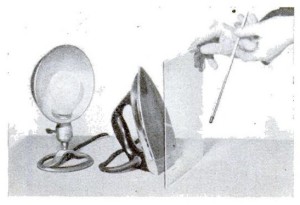 If Junior’s science fair project is due tomorrow, there’s still time to whip together a meaningful project, and this one from the May 1939 issue of Popular Science should fill the bill. You probably have all of the necessary parts at home. If you don’t, you should be able to find them at the trusty dollar store.
If Junior’s science fair project is due tomorrow, there’s still time to whip together a meaningful project, and this one from the May 1939 issue of Popular Science should fill the bill. You probably have all of the necessary parts at home. If you don’t, you should be able to find them at the trusty dollar store.
This experiment answers the question, “does a flame conduct electricity?” It turns out that it does, and this experiment proves it. All Junior needs (in addition to the obligatory poster board and magic markers) is a battery (a 9-volt battery should work fine), a pair of headphones (a cheap pair of stereo earbuds will do the trick), a few short pieces of wire, and a candle. And, of course, don’t forget to give Junior some matches or a lighter!
One terminal of the battery is hooked to the headphones. The other terminal of the battery and the other terminal of the headphones are each hooked to a piece of wire. Remove the insulation for the other end of those two wires. When Junior sticks the two wires into the flame of the candle, a clicking will be heard in the headphones, confirming that electrical current is flowing.
If Junior has more time to prepare his entry, he might want to consider more complex versions, such as the flame audion or the flame speaker.
 If you don’t trust Junior with matches, then the same magazine also shows the experiment shown here. Junior will need a piece of glass, an iron, a lamp (with an old-fashioned incandescent light bulb) and a thermometer. The glass will effectively block the heat from the iron. The radiant heat from the lamp, however, has a shorter wavelength and will pass through the glass. So when the iron is used, the thermometer won’t budge. But with the lamp, the temperature will rise quickly.
If you don’t trust Junior with matches, then the same magazine also shows the experiment shown here. Junior will need a piece of glass, an iron, a lamp (with an old-fashioned incandescent light bulb) and a thermometer. The glass will effectively block the heat from the iron. The radiant heat from the lamp, however, has a shorter wavelength and will pass through the glass. So when the iron is used, the thermometer won’t budge. But with the lamp, the temperature will rise quickly.
